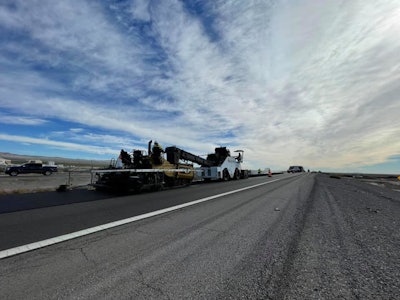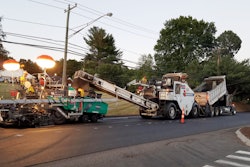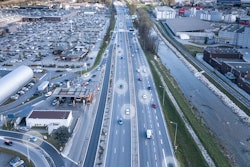
We did it. We got to the other side of the infrastructure bill— no small hurdle amid the political machinations in Washington, D.C. Now comes the challenge of putting the funds to work. So what exactly does $1.2 trillion dollars mean, especially for the road building industry?
If you go looking for signature projects that will help Americans understand what the bill is doing, you will struggle to find them. It will not create hundreds of bridges, as the New Deal did, or a national highway system, as Dwight Eisenhower did. But it will hopefully address the 173,000 miles of the nation's highways and major roads that are in poor condition. It also aims to help bring the 45,000 bridges which are also structurally deficient in to a state of good repair.
White House officials say the bill’s tangible benefits will become clearer to people in coming months and years. One thing we do know is that the majority of funding will flow through existing federal formulas to states and localities that have discretion over how the dollars are spent. In many cases, state and local agencies first need to decide what projects to pursue, but some states have calculated the money they are going to receive from the bill and are ready to put it to work.
West Virginia
Senator Joe Manchin (D-WV) has found notoriety as of late for expressing his concerns over the tying the Build Back Better reconciliation package to the IIJA. He delayed passage of both pieces of legislation until House leaders came to a compromise on the packages. With the passage of the infrastructure bill, his state of West Virginia will bring an estimated $6 billion in federal funding.
“This is one of the most important pieces of legislation we’ve done,” he told reporters in West Virginia. “Bipartisan infrastructure has been tried over the last 30 years and no president’s been able to get it done. It’s unbelievable.”
He said $3 billion will go to federal highway programs in the state; nearly $200 million will go to complete Corridor H of the Appalachian Development Highway System, which is known within the state as the Robert C. Byrd Highway System; $190 million for statewide transit; $43 million for state airports and $700 million to rehabilitate abandon mine lands.
Massachusetts
Over the next five years, based on formula funding alone and according to the White House, Massachusetts will receive a dedicated $4.2 billion for road improvements, $1.1 billion for bridge replacement and repair, and $2.5 billion for enhancing public transit systems like the MBTA. In addition, Massachusetts will receive $1.1 billion to improve its water infrastructure, helping to provide clean and safe drinking water across the Commonwealth.
Massachusetts is also expected to receive $244 million for airport infrastructure, at least $100 million to promote broadband access, $63 million for deploying electric vehicle charging infrastructure, $15.7 million to strengthen cybersecurity, and $5.8 million to protect against wildfires. In total, Massachusetts is set to benefit from more than $9 billion in federal investment, while the state can also compete to receive billions more under the infrastructure bill’s numerous grant programs.
“This bill includes key funding and policies to begin transforming our physical infrastructure for the 21st century, while promoting greater equity and starting to solve long-unaddressed safety challenges," Senator Edward J. Markey (D-MA) said. "By investing billions more in Massachusetts, we can finally begin the process of replacing the Cape Cod bridges and updating the MBTA to make it more efficient and climate resilient. We can also advance essential projects like East-West Rail and help close our digital divide by connecting families from the Berkshires to Boston with high-speed internet. We will reduce roadway fatalities and promote clean drinking water across the Commonwealth, while creating good-paying jobs and spurring new economic growth."
Ohio
U.S. Senator Rob Portman (R-OH) announced that his bipartisan Bridge Investment Act is expected to be signed into law, as part of the IIJA. This bill would establish a competitive grant program to assist the repair and replacement of deficient and outdated bridges and ease the national bridge repair backlog. It will also help the state get closer to a solution on the Brent Spence Bridge in Cincinnati by providing billions in available funding to go alongside a local match that can pay for a long-term solution to address the high volume of bridge traffic.
“I’m pleased that the Bridge Investment Act, included in the Infrastructure Investment and Jobs Act, has now passed the House, and will be signed into law soon by the President. This additional federal funding means we are one step closer to a solution for the Brent Spence Bridge,” said Portman.
The bipartisan infrastructure legislation also includes a new formula grant program for states dedicated to providing further funding to our nation’s bridges. Over the next five years, this formula grant program will provide an additional $483 million over the next five years for the state of Ohio.
Louisiana
The Louisiana Department of Transportation and Development announced that the state is slated to receive nearly $6 billion from the IIJA. The state says they are well positioned to compete for billions more with the Bridge Investment Program and other major projects that will deliver substantial economic benefits to communities across Louisiana, including broadband, resiliency, ports and rail.
“The IIJA is crucial for Louisiana, as it will allow the state to advance several much-needed major road and bridge projects in which funding has not yet been fully identified,” said DOTD Secretary Shawn D. Wilson, Ph.D., President of the American Association of State Highway and Transportation Officials. “Our state’s infrastructure system is relying solely on a fuel tax that’s over 30 years old; as a result, we have a backlog of $15 billion in road and bridge repairs that will never be eliminated with the current gas tax. In recent years we’ve relied heavily on federal dollars and innovative funding methods, such as public-private partnerships, to continue investing in our aging transportation system. Not only will this act benefit infrastructure projects, but it will also greatly help our multimodal system such as our waterways, ports and rail programs. With this funding, DOTD will be able to close the gap in funding on major projects and implement more projects to help slow the backlog of growing needs. I applaud Senator Bill Cassidy of our state who was instrumental in gathering bipartisan support for this bill in the Senate, and we are grateful for his hard work. I would also like to thank Congressman Troy Carter for his vote and continued support to improve Louisiana’s infrastructure.”
Statewide, funding from the IIJA will be allocated to:
- $4.8 billion to highways
- $1.01 billion to bridges
- $470 million to public transportation
- $73 million to Electric Vehicle Infrastructure
- $179 million to airports
- And $20 million to a more resilient transportation system that has the capability to recover from disruptions such as extreme weather
Washington
Under the IIJA, the state of Washington will see nearly $8.6 billion in dedicated funds and billions more in potential grants for everything from highways and bridges to electric vehicle charging stations and broadband to public transit and safer drinking water. The result will be a massive, necessary boost for a state where infrastructure construction and funding hasn’t kept up with population growth or economic expansion.
“We view it as a game changer,” said Peter Rogoff, CEO of Sound Transit, which will get around $380 million in dedicated funding for the regional light rail system, and will also compete for federal grants available in the measure, which contains around $550 billion in new spending.
Under the IIJA package, Washington over the next five years will receive around $4.7 billion for highways and $605 million for bridges and another $1.8 billion in public transportation spending; $882 million to improve drinking water infrastructure and safety; and $385 million for the state’s airports, including $228 million for Sea-Tac International Airport and $16 million for Paine Field in Snohomish County, according to estimates provided by the White House.
Maryland
After passage of the IIJA, President Joe Biden arranged a tour of the Port of Baltimore and spoke to the media using the Baltimore port, which has avoided the shipping bottlenecks seen at other other ports, as an example of what is to come with further investment in the country’s shipping infrastructure.
The United States ports-related components of the IIJA are front and center, with the heavy amount of attention being given to the ongoing supply chain challenges.
This is highlighted by the allocation of $17 billion in the legislation to improve infrastructure at coastal ports, inland ports and waterways, and land ports of entry along the border.
Ultimate Impact of IIJA TBD
The infrastructure bill’s ultimate popularity will depend on whether people can cite specific examples of how it has affected their lives and time will tell how states put the money to work.
The American Association of Highway & Transportation Officials (AASHTO) developed a state by state benefit document which outline how each state will benefit from the IIJA. They also prepared a funding table for the amount of money each state can expect from the plan. You can view it here.
*This article will be updated with more projects being announced as a result of the passage of the IIJA.




















